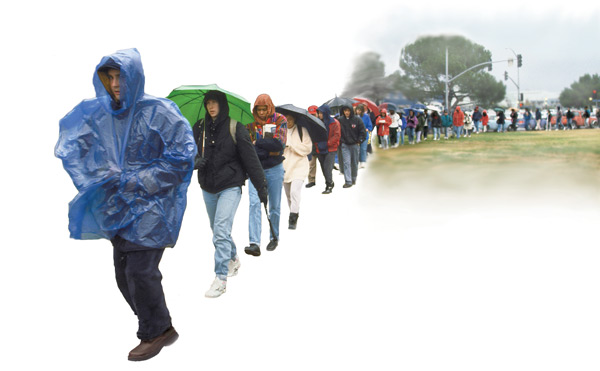| |
View From an Incoming Freshman: Campus Technology Transforms Matriculation By Mara Abrams, student
Course RegistrationOne campus unit that has evolved parallel to advancing technology is the Office of the Registrar, the unit responsible for handling student enrollment in the thousands of courses offered on campus. Believe it or not, this process once involved pencil and paper. Students had to fill out a form with their top six class choices and drop it off at the Registrar's Office, according to Associate Registrar Don Barclift. Office employees would then manually key the students' information into an algorithm-based scheduling system. If students didn't like the classes that they were assigned, they would have to then go to the Rec Hall, where campus departments set up tables where students could request changes. The lines leading to the tables would often snake out the doors and around the grassy area outside of the Rec Hall, extending all the way onto the sidewalks of La Rue Road (as shown below in the photo circa 1990).Thanks to emerging technology, the Registrar's Office was able to do away with these impossibly long lines (and tedious labor) by establishing the telephone registration system, RSVP, in 1993. It's hard to believe that students once had to register for classes in-person, but it demonstrates the extent to which technology has impacted the functioning of this campus. Nine years after its arrival, RSVP was retired in December 2002 to make way for Web registration to become the sole method for course registration. The Registrar worked with IET to develop Web-based registration and for a four–year period made available both phone and Web-based registration methods. But by 2002, it became clear that students considered the telephone an obsolete means of course registration when they could use the Web instead. "RSVP and the Web alike have eliminated long lines of students at the Registrar's Office, and at many other offices on campus, as well" explains Barclift. In addition, the Web has allowed students to update their addresses, file for graduation, and check grades, all entirely online. The general catalog, schedule of classes, and Degree Navigator are also available on the Web, as well as class rosters for department staff's viewing. "Technology has allowed the Registrar's Office to improve efficiency and customer service, allowing the student and departments a more self-service approach," Barclift continues.
Computing AccountsAnother staple of the college matriculation process for the past ten years has been obtaining a computing account. Students sign up for these practically as soon as they are admitted so they can initiate their campus identity with an "@ucdavis.edu" email account and begin to use the campus' online services. The process of doing so has changed over the years, says Beau Patrette, Manager of IT Express, UC Davis' computing help desk. While students once had to stand in lines and fill out forms by hand to register for an account, now they do so online using a Web site developed three years ago (http://computingaccounts.ucdavis.edu/) by Information and Educational Technology (IET). In the interim, Patrette explains, the text-based program Telnet was used for account registration.
RecruitmentIt is clear that this past decade has brought about changes for enrolled students, but recent technologies have also benefited prospective students. The Office of Undergraduate Admissions and Outreach now utilizes WhyUCDavis, an e-recruitment Web site, as one of their key promotional tools. WhyUCDavis has not replaced the campus' traditional marketing methods, such as the use of brochures and campus tours, but rather has changed the focus of UC Davis outreach. Print publications, which are getting smaller, tend to encourage students to visit specific Web sites for more information.According to Alice Hom, associate director of Undergraduate Admissions and Outreach Services, Davis was struggling to maintain its competitive position within the UC system in terms of being a first choice campus among high school graduates looking to attend a UC. WhyUCDavis, a collaborative effort involving several campus units, was created in an effort to improve the image of UC Davis by keeping up with prospective students' demand for Web-based information about colleges. The pilot version of WhyUCDavis rolled out in March 2001 and catered
specifically to students newly admitted to the Humanities, Arts
and Cultural Studies (HArCS) academic program in the College of
Letters and Science. Cross-collaboration between HArCS, Public Communications,
IET, Student Affairs Research and Information, Undergraduate Admissions
and Outreach Services and most recently, the College of Agricultural
and Environmental Sciences and Advising Services has since allowed
the site to take flight. The current version now targets prospective
students of all majors. Since its introduction last March, 162,081
unique users have visited the site. This substantial number suggests
the contribution technology has made to our more traditional outreach
approaches in a fairly short amount of time. So what's in store for freshman matriculation in the next 10 years? Barclift is hopeful that we have only begun to see the potential of technology to inform and respond to student needs and expectations. "Technology will continue to play a key role in the future. We will continue to keep current with technology advances in order to improve the services we offer our students and the campus community," he says.
|
 Before the advent of SISweb, students would wait in line to
either use telephones or speak to an advisor to register classes
(Photo courtesy of IET-Mediaworks).
Before the advent of SISweb, students would wait in line to
either use telephones or speak to an advisor to register classes
(Photo courtesy of IET-Mediaworks).
